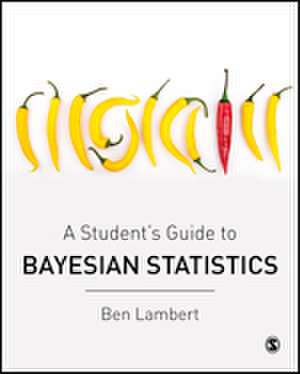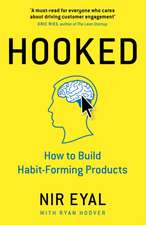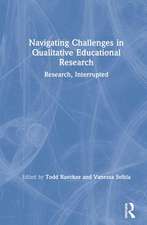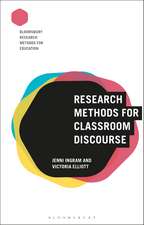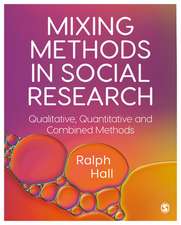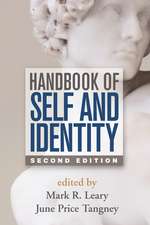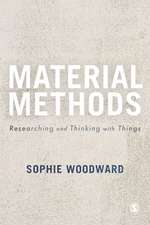A Student’s Guide to Bayesian Statistics
Autor Ben Lamberten Limba Engleză Paperback – 3 mai 2018
Without sacrificing technical integrity for the sake of simplicity, the author draws upon accessible, student-friendly language to provide approachable instruction perfectly aimed at statistics and Bayesian newcomers. Through a logical structure that introduces and builds upon key concepts in a gradual way and slowly acclimatizes students to using R and Stan software, the book covers:
- An introduction to probability and Bayesian inference
- Understanding Bayes' rule
- Nuts and bolts of Bayesian analytic methods
- Computational Bayes and real-world Bayesian analysis
- Regression analysis and hierarchical methods
Preț: 399.74 lei
Nou
Puncte Express: 600
Preț estimativ în valută:
76.50€ • 83.07$ • 64.26£
76.50€ • 83.07$ • 64.26£
Carte disponibilă
Livrare economică 01-15 aprilie
Livrare express 15-21 martie pentru 58.30 lei
Preluare comenzi: 021 569.72.76
Specificații
ISBN-13: 9781473916364
ISBN-10: 1473916364
Pagini: 520
Dimensiuni: 189 x 246 x 36 mm
Greutate: 0.98 kg
Ediția:1
Editura: SAGE Publications
Colecția Sage Publications Ltd
Locul publicării:London, United Kingdom
ISBN-10: 1473916364
Pagini: 520
Dimensiuni: 189 x 246 x 36 mm
Greutate: 0.98 kg
Ediția:1
Editura: SAGE Publications
Colecția Sage Publications Ltd
Locul publicării:London, United Kingdom
Recenzii
An excellent resource on Bayesian analysis accessible to students from a diverse range of statistical backgrounds and interests. Easy to follow with well documented examples to illustrate key concepts.
When I was a grad student, Bayesian statistics was restricted to those with the mathematical fortitude to plough through source literature. Thanks to Lambert, we now have something we can give to the modern generation of nascent data scientists as a first course. Love the supporting videos, too!
Written in highly accessible language, this book is the gateway for students to gain a deep understanding of the logic of Bayesian analysis and to apply that logic with numerous carefully selected hands-on examples. Lambert moves seamlessly from a traditional Bayesian approach (using analytic methods) that serves to solidify fundamental concepts, to a modern Bayesian approach (using computational sampling methods) that endows students with the powerful and practical powers of application. I would recommend this book and its accompanying materials to any students or researchers who wish to learn and actually do Bayesian modeling.
A balanced combination of theory, application and implementation of Bayesian statistics in a not very technical language. A tangible introduction to intangible concepts of Bayesian statistics for beginners.
The late, famous statistician Jimmie Savage would have taken great pleasure in this book based on his work in the 1960s on Bayesian statistics. He would have marveled at the presentations in the book of many new and strong statistical and computer analyses.
While there is increasing interest in Bayesian statistics among scholars of different social science disciplines, I always looked for a text book which is accessible to a wide range of students who do not necessarily have extended knowledge of statistics. Now, I believe that this is the first textbook of Bayesian statistics, which can also be used for social science undergraduate students. Ben Lambert begins with a general introduction to statistical inference and successfully brings the readers to more specific and practical aspects of Bayesian inference. In addition to its well-considered structure, many graphical presentations and reasonable examples contribute for a broader audience to obtain well-founded understanding of Bayesian statistics.
This book offers a path to get into the field of Bayesian statistics with no previous knowledge. Building from elementary to advanced topics, including theoretic and computational aspects, and focusing on the application, it is an excellent read for newcomers to the Bayesian world.
When I was a grad student, Bayesian statistics was restricted to those with the mathematical fortitude to plough through source literature. Thanks to Lambert, we now have something we can give to the modern generation of nascent data scientists as a first course. Love the supporting videos, too!
Written in highly accessible language, this book is the gateway for students to gain a deep understanding of the logic of Bayesian analysis and to apply that logic with numerous carefully selected hands-on examples. Lambert moves seamlessly from a traditional Bayesian approach (using analytic methods) that serves to solidify fundamental concepts, to a modern Bayesian approach (using computational sampling methods) that endows students with the powerful and practical powers of application. I would recommend this book and its accompanying materials to any students or researchers who wish to learn and actually do Bayesian modeling.
A balanced combination of theory, application and implementation of Bayesian statistics in a not very technical language. A tangible introduction to intangible concepts of Bayesian statistics for beginners.
The late, famous statistician Jimmie Savage would have taken great pleasure in this book based on his work in the 1960s on Bayesian statistics. He would have marveled at the presentations in the book of many new and strong statistical and computer analyses.
While there is increasing interest in Bayesian statistics among scholars of different social science disciplines, I always looked for a text book which is accessible to a wide range of students who do not necessarily have extended knowledge of statistics. Now, I believe that this is the first textbook of Bayesian statistics, which can also be used for social science undergraduate students. Ben Lambert begins with a general introduction to statistical inference and successfully brings the readers to more specific and practical aspects of Bayesian inference. In addition to its well-considered structure, many graphical presentations and reasonable examples contribute for a broader audience to obtain well-founded understanding of Bayesian statistics.
This book offers a path to get into the field of Bayesian statistics with no previous knowledge. Building from elementary to advanced topics, including theoretic and computational aspects, and focusing on the application, it is an excellent read for newcomers to the Bayesian world.
Cuprins
Chapter 1: How to best use this book
The purpose of this book
Who is this book for?
Pre-requisites
Book outline
Route planner - suggested journeys through Bayesland
Video
Problem sets
Code
R and Stan
Why don’t more people use Bayesian statistics?
What are the tangible (non-academic) benefits of Bayesian statistics?
Part I: An introduction to Bayesian inference
Chapter 2: The subjective worlds of Frequentist and Bayesian statistics
Bayes’ rule - allowing us to go from the effect back to its cause
The purpose of statistical inference
The world according to Frequentists
The world according to Bayesians
Do parameters actually exist and have a point value?
Frequentist and Bayesian inference
Bayesian inference via Bayes’ rule
Implicit versus Explicit subjectivity
Chapter 3: Probability - the nuts and bolts of Bayesian inference
Probability distributions: helping us explicitly state our ignorance
Independence
Central Limit Theorems
A derivation of Bayes’ rule
The Bayesian inference process from the Bayesian formula
Part II: Understanding the Bayesian formula
Chapter 4: Likelihoods
What is a likelihood?
Why use ‘likelihood’ rather than ‘probability’?
What are models and why do we need them?
How to choose an appropriate likelihood?
Exchangeability vs random sampling
Maximum likelihood - a short introduction
Chapter 5: Priors
What are priors, and what do they represent?
The explicit subjectivity of priors
Combining a prior and likelihood to form a posterior
Constructing priors
A strong model is less sensitive to prior choice
Chapter 6: The devil’s in the denominator
An introduction to the denominator
The difficulty with the denominator
How to dispense with the difficulty: Bayesian computation
Chapter 7: The posterior - the goal of Bayesian inference
Expressing parameter uncertainty in posteriors
Bayesian statistics: updating our pre-data uncertainty
The intuition behind Bayes’ rule for inference
Point parameter estimates
Intervals of uncertainty
From posterior to predictions by sampling
Part III: Analytic Bayesian methods
Chapter 8: An introduction to distributions for the mathematically-un-inclined
The interrelation among distributions
Sampling distributions for likelihoods
Prior distributions
How to choose a likelihood
Table of common likelihoods, their uses, and reasonable priors
Distributions of distributions, and mixtures - link to website, and relevance
Chapter 9: Conjugate priors and their place in Bayesian analysis
What is a conjugate prior and why are they useful?
Gamma-poisson example
Normal example: giraffe height
Table of conjugate priors
The lessons and limits of a conjugate analysis
Chapter 10: Evaluation of model fit and hypothesis testing
Posterior predictive checks
Why do we call it a p value?
Statistics measuring predictive accuracy: AIC, Deviance, WAIC and LOO-CV
Marginal likelihoods and Bayes factors
Choosing one model, or a number?
Sensitivity analysis
Chapter 11: Making Bayesian analysis objective?
The illusion of the ’uninformative’ uniform prior
Jeffreys’ priors
Reference priors
Empirical Bayes
A move towards weakly informative priors
Part IV: A practical guide to doing real life Bayesian analysis: Computational Bayes
Chapter 12: Leaving conjugates behind: Markov Chain Monte Carlo
The difficulty with real life Bayesian inference
Discrete approximation to continuous posteriors
The posterior through quadrature
Integrating using independent samples: an introduction to Monte Carlo
Why is independent sampling easier said than done?
Ideal sampling from a posterior using only the un-normalised posterior
Moving from independent to dependent sampling
What’s the catch with dependent samplers?
Chapter 13: Random Walk Metropolis
Sustainable fishing
Prospecting for gold
Defining the Metropolis algorithm
When does Metropolis work?
Efficiency of convergence: the importance of choosing the right proposal scale
Metropolis-Hastings
Judging convergence
Effective sample size revisited
Chapter 14: Gibbs sampling
Back to prospecting for gold
Defining the Gibbs algorithm
Gibbs’ earth: the intuition behind the Gibbs algorithm
The benefits and problems with Gibbs and Random Walk Metropolis
A change of parameters to speed up exploration
Chapter 15: Hamiltonian Monte Carlo
Hamiltonian Monte Carlo as a sledge
NLP space
Solving for the sledge motion over NLP space
How to shove the sledge
The acceptance probability of HMC
The complete Hamiltonian Monte Carlo algorithm
The performance of HMC versus Random Walk Metropolis and Gibbs
Optimal step length of HMC: introducing the “No U-Turn Sampler”
Chapter 16: Stan
Why Stan, and how to get it
Getting setup with Stan using RStan
Our first words in Stan
Essential Stan reading
What to do when things go wrong
How to get further help
Part V: Hierarchical models and regression
Chapter 17: Hierarchical models
The spectrum from fully-pooled to heterogeneous
Non-centered parameterisations in hierarchical models
Case study: Forecasting the EU referendum result
The importance of fake data simulation for complex models
Chapter 18: Linear regression models
Example: high school test scores in England
Pooled model
Interactions
Heterogeneous coefficient model
Hierarchical model
Incorporating LEA-level data
Chapter 19: Generalised linear models and other animals
Example: electoral participation in European countries
Discrete parameter models in Stan
The purpose of this book
Who is this book for?
Pre-requisites
Book outline
Route planner - suggested journeys through Bayesland
Video
Problem sets
Code
R and Stan
Why don’t more people use Bayesian statistics?
What are the tangible (non-academic) benefits of Bayesian statistics?
Part I: An introduction to Bayesian inference
Chapter 2: The subjective worlds of Frequentist and Bayesian statistics
Bayes’ rule - allowing us to go from the effect back to its cause
The purpose of statistical inference
The world according to Frequentists
The world according to Bayesians
Do parameters actually exist and have a point value?
Frequentist and Bayesian inference
Bayesian inference via Bayes’ rule
Implicit versus Explicit subjectivity
Chapter 3: Probability - the nuts and bolts of Bayesian inference
Probability distributions: helping us explicitly state our ignorance
Independence
Central Limit Theorems
A derivation of Bayes’ rule
The Bayesian inference process from the Bayesian formula
Part II: Understanding the Bayesian formula
Chapter 4: Likelihoods
What is a likelihood?
Why use ‘likelihood’ rather than ‘probability’?
What are models and why do we need them?
How to choose an appropriate likelihood?
Exchangeability vs random sampling
Maximum likelihood - a short introduction
Chapter 5: Priors
What are priors, and what do they represent?
The explicit subjectivity of priors
Combining a prior and likelihood to form a posterior
Constructing priors
A strong model is less sensitive to prior choice
Chapter 6: The devil’s in the denominator
An introduction to the denominator
The difficulty with the denominator
How to dispense with the difficulty: Bayesian computation
Chapter 7: The posterior - the goal of Bayesian inference
Expressing parameter uncertainty in posteriors
Bayesian statistics: updating our pre-data uncertainty
The intuition behind Bayes’ rule for inference
Point parameter estimates
Intervals of uncertainty
From posterior to predictions by sampling
Part III: Analytic Bayesian methods
Chapter 8: An introduction to distributions for the mathematically-un-inclined
The interrelation among distributions
Sampling distributions for likelihoods
Prior distributions
How to choose a likelihood
Table of common likelihoods, their uses, and reasonable priors
Distributions of distributions, and mixtures - link to website, and relevance
Chapter 9: Conjugate priors and their place in Bayesian analysis
What is a conjugate prior and why are they useful?
Gamma-poisson example
Normal example: giraffe height
Table of conjugate priors
The lessons and limits of a conjugate analysis
Chapter 10: Evaluation of model fit and hypothesis testing
Posterior predictive checks
Why do we call it a p value?
Statistics measuring predictive accuracy: AIC, Deviance, WAIC and LOO-CV
Marginal likelihoods and Bayes factors
Choosing one model, or a number?
Sensitivity analysis
Chapter 11: Making Bayesian analysis objective?
The illusion of the ’uninformative’ uniform prior
Jeffreys’ priors
Reference priors
Empirical Bayes
A move towards weakly informative priors
Part IV: A practical guide to doing real life Bayesian analysis: Computational Bayes
Chapter 12: Leaving conjugates behind: Markov Chain Monte Carlo
The difficulty with real life Bayesian inference
Discrete approximation to continuous posteriors
The posterior through quadrature
Integrating using independent samples: an introduction to Monte Carlo
Why is independent sampling easier said than done?
Ideal sampling from a posterior using only the un-normalised posterior
Moving from independent to dependent sampling
What’s the catch with dependent samplers?
Chapter 13: Random Walk Metropolis
Sustainable fishing
Prospecting for gold
Defining the Metropolis algorithm
When does Metropolis work?
Efficiency of convergence: the importance of choosing the right proposal scale
Metropolis-Hastings
Judging convergence
Effective sample size revisited
Chapter 14: Gibbs sampling
Back to prospecting for gold
Defining the Gibbs algorithm
Gibbs’ earth: the intuition behind the Gibbs algorithm
The benefits and problems with Gibbs and Random Walk Metropolis
A change of parameters to speed up exploration
Chapter 15: Hamiltonian Monte Carlo
Hamiltonian Monte Carlo as a sledge
NLP space
Solving for the sledge motion over NLP space
How to shove the sledge
The acceptance probability of HMC
The complete Hamiltonian Monte Carlo algorithm
The performance of HMC versus Random Walk Metropolis and Gibbs
Optimal step length of HMC: introducing the “No U-Turn Sampler”
Chapter 16: Stan
Why Stan, and how to get it
Getting setup with Stan using RStan
Our first words in Stan
Essential Stan reading
What to do when things go wrong
How to get further help
Part V: Hierarchical models and regression
Chapter 17: Hierarchical models
The spectrum from fully-pooled to heterogeneous
Non-centered parameterisations in hierarchical models
Case study: Forecasting the EU referendum result
The importance of fake data simulation for complex models
Chapter 18: Linear regression models
Example: high school test scores in England
Pooled model
Interactions
Heterogeneous coefficient model
Hierarchical model
Incorporating LEA-level data
Chapter 19: Generalised linear models and other animals
Example: electoral participation in European countries
Discrete parameter models in Stan
Notă biografică
Ben Lambert is a researcher at Imperial College London where he works on the epidemiology of malaria. He has worked in applied statistical inference for about a decade, formerly at the University of Oxford, and is the author of over 500 online lectures on econometrics and statistics. He also somewhat strangely went to school in Thomas Bayes¿ home town for many years, Tunbridge Wells.
Descriere
Without sacrificing technical integrity for the sake of simplicity, the author draws upon accessible, student-friendly language to provide approachable instruction perfectly aimed at statistics and Bayesian newcomers.
